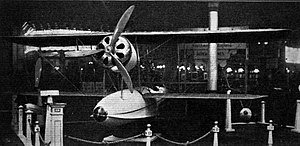| Pemberton-Billing P.B.1 | |
|---|---|

| |
| The P.B. 1 on display at the Olympia Exhibition, London in March 1914 | |
| Role | Single-seat flying boatType of aircraft |
| National origin | United Kingdom |
| Manufacturer | Pemberton-Billing Limited |
| Designer | Noel Pemberton-Billing |
| First flight | 1914 (although it may never have flown) |
| Status | dismantled |
| Number built | 1 |
The Pemberton-Billing P.B.1, sometimes known as the Supermarine, was a 1910s British single-seat flying-boat built by Pemberton-Billing Limited, which later became the Supermarine Aviation Works. Only one P.B.1 was built, and it never flew any distance further than a hop.
Design and development
The P.B.1 was a single-seat open cockpit biplane powered by a 50 hp (36 kW) Gnome rotary engine driving a three-bladed pusher propeller, which was mounted in a tractor configuration nacelle between the upper wings and the fuselage. It had a single-step hull designed by the naval architect Linton Hope, with a spruce skin over a mahogany structure, and covered with waterproof fabric. It had two-bay wings constructed of spruce and Ash, with ailerons on the upper wing and floats under the lower wingtips. The pilot sat in a cockpit aft of the wing trailing edge.
Described as "a boat that will fly, an aeroplane that will float", only one P.B.1 was built; the prototype was displayed at the Olympia Aero Show in March 1914. It was rebuilt during April 1914, with the pilot's cockpit moved forward to the nose of the aircraft, and the Gnome engine mounted on top of the fuselage, driving two 3-bladed pusher propellers via chain drives. Following the modifications, the P.B.1 entered testing, but failed to achieve flight during testing on Southampton Water on 30 May 1914. Noel Pemberton Billing, the head of Pemberton-Billing Limited and designer of the PB.1, claimed that the aircraft made a short hop during June, but other sources state that the PB.1 never flew.
Following the conclusion of the attempted flight testing, the P.B.1 was dismantled on 28 July 1914, with its engine being used in the Pemberton-Billing P.B.9 single seat scout aircraft.
Specifications (P.B.1)
Data from British Flying Boats
General characteristics
- Crew: 1
- Wingspan: 30 ft 0 in (9.14 m)
- Wing area: 293 sq ft (27.2 m)
- Empty weight: 750 lb (340 kg)
- Gross weight: 970 lb (440 kg)
- Powerplant: 1 × Gnome rotary , 50 hp (37 kW)
Performance
- Maximum speed: 50 mph (80 km/h, 43 kn) (estimated)
See also
Related lists
References
Notes
- Pemberton Billing aircraft underwent a retrospective redesignation in 1916, with the original P.B.1 design, as displayed at Olympia, redesignated P.B.7, and the modified aircraft as tested during May–June 1914 redesignated P.B.9. The P.B.9 landplane scout, which was built in August 1914 using the engine of the P.B.1 became the P.B.13 as part of the same redesignation.
Citations
- ^ Jarrett Air Enthusiast Forty-eight, p. 10.
- Bruce 1969, p. 60.
- ^ "The Olympia Exhibition: The Supermarine P.B.1 (Pemberton Billing). (49.)". Flight. 21 March 1914. p. 301.
- London 2003, p. 8.
- ^ Jarrett Air Enthusiast Forty-eight, pp. 7–8.
- ^ Jarrett Air Enthusiast Forty-eight, p. 9.
- London 2003, pp. 8–9.
- Andrews and Morgan 1987, p. 15.
- London 2003, pp. 262–263.
Bibliography
- Andrews, C.F.; Morgan, E.B. (1987). Supermarine Aircraft since 1914. London: Putnam. ISBN 0-85177-800-3.
- Bruce, J.M. (1969). War Planes of the First World War: Volume Three: Fighters. London: Macdonald & Co. ISBN 0-356-01490-8.
- Jarrett, Philip (December 1992 – February 1993). "Supermarine Origins: Pemberton-Billing Flying Boats". Air Enthusiast. No. Forty–eight. pp. 4–10. ISSN 0143-5450.
- London, Peter (2003). British Flying Boats. Stroud, UK: Sutton Publishing. ISBN 0-7509-2695-3.